My go-to Idli Dosa Batter
Step by step process to make Idli Dosa Batter at home! This no fail recipe will make sure you master the technique in no time!
This post may contain affiliate links. Please read our disclosure policy.
My go-to Idli Dosa Batter! This batter makes soft and spongy idlis and crispy dosa.
The batter is made in a high speed blender like blendtec and fermented in the Instant Pot.
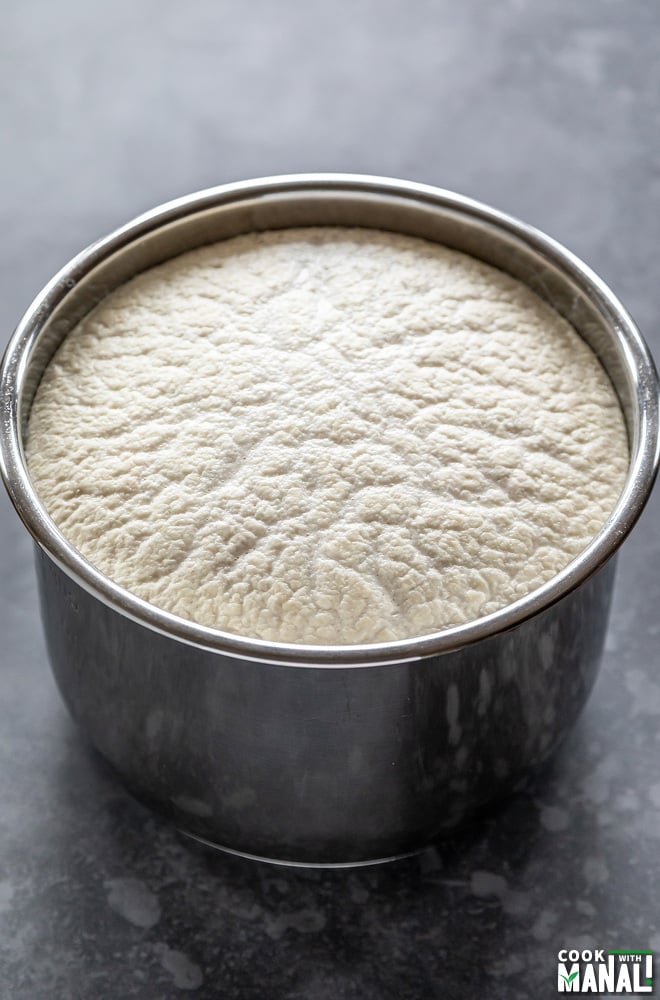
I have been meaning to share this post for so long, like really long.
Few weeks back, I shared the entire process of making Idli Dosa batter on my Instagram stories and it received an overwhelming response.
I got so many requests to write a blog post about it and well here I am. Sorry for the delay but better late than never I guess?
This is my go to Idli Dosa Batter and I make it all the time.
I grew up in north India where Idli and Dosa are not a everyday thing. Indian food is very versatile and what people in the north eat is very different from what people in south eat which is again very different from what people in east eat.
You get the drift? In the western world, Indian food = curry + naan.
That’s so far from reality. Like really really far.
Anyway, so because I grew up in north India, my mom did not make idli and dosa at home.
For those who don’t know, idli is a steamed cake made with a rice and lentil fermented batter. The same batter is also used to make a crepe called dosa which is often filled with spicy potato filling among many other things.
For us, eating South Indian food was mostly restricted to restaurants. And once in a while when dosa was made at a home, it was always from store bought batter.
I don’t ever remember mom making the batter at home. Of course this is not to say that every North Indian house must be same. But I would say it would hold true for majority.
So when I started cooking, I had zero knowledge about south Indian cooking.
At least I had seen mom make all the parathas and dals etc. all the time. But I had no clue how idli and dosa were made.
After reading so many tutorials online, I started experimenting. And this was around 3 to 4 years ago.
I can’t tell you the number of times I failed. I would follow the recipe to the “T” but my batter won’t ferment.
Because I failed so much, I learnt a lot too. Isn’t that’s how it always is? You always learn from your failures.
Slowly, I started getting a hang of it and also realized the mistakes that I was making.
And once I started using my Instant Pot to ferment the batter, there was no looking back!
How to Make the Perfect Idli Dosa Batter
I am going to share with you guys all that I have learnt through trials and errors all these years in getting my Idli Dosa batter right.
And I will also try and answer all the frequently asked questions! So let’s go!
Ratio of Dal to Rice
Ahh, the most important question. What should be the ratio of dal to rice for making idlis and dosa.
I have tried a lot. I have done 1:2, 1:1, 1:3 (dal to rice) but the one that works the best for me is 1:4!
So, for every 1 cup of dal, I use 4 cups of rice. This ratio works for both idli and dosa.
Which Rice to use
I highly recommend using Idli Rice here, which is a variety of short-grain parboiled rice. You can find it at any Indian grocery store.
Short to medium grain rice work best for this recipe. I wouldn’t recommend using long grain basmati rice for this recipe.
You can use par boiled sona masoori or ponni rice too.
Which Dal to use
Black gram or urad dal is what is used in making this batter.
Dehusked Whole urad dal works best here (urad dal gota). You can also use split urad dal (urad dal dhuli).
Adding fenugreek (methi)
I always add some fenugreek seeds (methi seeds) to the batter.
It helps in fermentation. And it also helps in giving the dosa a nice brown color.
How much water to use to grind the batter?
Okay, when I didn’t know how to make the batter, I read several recipes online and a lot of them asked to add little water while grinding.
The result was that I always ended up adding way too little water to my batter.
I thought the batter need to be thick which is not the case at all.
The batter should have a nice flowing consistency (it should not be runny though). Add enough water to grind the batter and don’t be scared to add water like I was!
For 1/2 cup dal, I usually add around 1/2 to 3/4 cup water to grind.
For 2 cups rice, I usually add around 3/4 to 1 cup water to grind.
The amount of water will depend on the type of rice/dal you use.
To add salt before or after fermentation
There are conflicting thoughts on this.
My personal experience is to add the salt before fermentation.
Maybe, it’s because I live in a cold place. I have never made this batter in India but if I was, I probably won’t add salt before fermentation.
But here in Seattle, I always do as I feel it helps in fermentation.
And I always use Sendha Namak (Rock Salt). The regular salt with iodine might interfere with fermentation process and hence better to use a non-iodized salt.
Mixing the batter with clean hands
Once you have ground the dal and rice, you mix them together with clean hands.
I usually mix using my hands for good 2 minutes.
Trust me, it makes a difference. Mixing with hands helps in the fermentation process so don’t skip this step.
Frequently Asked Questions
Which blender to use to grind the dal and rice
Wet grinder is traditionally used.
However, I just use my Blendtec. Any high speed blender will do.
On my blendtec, I usually press the smoothie button or the soup button.
How to ferment the batter
The batter needs warm place in order to ferment.
If you live in a warm place, you can leave the batter on the counter and it will ferment.
However, if you live in a cold place like I do.
You either place the batter in the oven with the oven lights on.
Or use your Instant Pot!
Ever since I have got my Instant Pot, I always use it to ferment my batter.
It gives consistent results. So, I just place the batter in the pot, cover with a glass lid and press the yogurt button.
How long it takes for the batter to ferment?
Now, that would depend on where you live.
Warm places, it might ferment in 6 to 8 hours.
Usually here in Seattle, it takes around 12 to 13 hours to ferment.
Why not soak dal rice together?
So, when I posted the Instagram stories, I had several people ask why not soak the dal and rice together?
I mean it will be just more convenient right?
Well the reason is that rice and dal have different texture.
You want the dal to have a fluffy texture which is important for idlis. And you can’t achieve that if you soak and grind the dal together with the rice.
For this reason, it needs to be grind separately. However, if you are only going to make dosa, then you may soak and grind them together.
How to know if batter has fermented?
The batter will obviously increase in volume.
You would see bubbles on top and it will be all frothy.
Another great way to check- take water in a bowl and then drop some batter into it.
The batter should float, which means its light, airy and fermented and ready to make idlis!
If it hasn’t fermented, let it ferment for some more time.
Okay guys, I hope that was helpful. I have tried to cover everything I could think of.
If there are any more questions, please leave them in the comments section below and I will try to get back as soon as possible.
Method
1- Rinse the dal under running water.
2- Then soak the dal in enough water (2-3 cups) for around 5 to 6 hours. Add 1 teaspoon methi seeds to the dal while it’s soaking.
3- Rinse the rice under running water until water turns clear.
4- Then soak the rice in enough water for around 5 to 6 hours, same time as the dal.
5- After 5 to 6 hours have passed, drain the water from the dal. Transfer the dal to the blender (or any grinder that you use).
6- Add 1.25 (10 oz) to 1.5 (12 oz) cups ice cold water and grind the dal to a fine paste. I use my blendtec and press the smoothie or soup button usually.
7- Transfer the ground dal to the steel pot of your Instant Pot (if using IP to ferment the batter) or to any other large container.
8- Now drain the rice and add it to the same blender along with 1.5 (12 oz) to 2 cups (16 oz) ice cold water.
The amount of water will depend on the type of rice/dal you use. So, start with lesser amount and add more water as needed.
9- Grind rice to a smooth paste.
10- Now, transfer the ground rice to the same pot as the dal.
11- Add sendha namak (rock salt) to the rice and dal mixture.
12- Now, start using your hands and mix the salt and the batter together for 1-2 minutes using your hands. Mixing by hands help in fermentation process.
13- The consistency of the batter should be free flowing, but it shouldn’t be runny.
14- Now cover the pot with a glass lid (if using Instant Pot) or with any other lid if using regular container. The reason I use glass lid for fermenting the batter in Instant Pot and not it’s regular lid is because the batter may overflow and that can lock the lid.
So it’s better to use a glass lid.
15- If using Instant Pot for fermentation, now press the Yogurt button. Increase the time to 12-14 hours. The time will depend on where you live. Here it takes around 12-14 hours for the batter to ferment.
If not using an Instant Pot, cover the container and place in an oven with lights on (especially if you live in a cold place). If you live in a very warm place, then simply keep the batter on the counter to ferment.
16- After 14 hours, my batter was well fermented and ready to make idlis! It had increased in volume and was frothy and bubbly.
To check you can also drop a small drop of batter in a bowl with clean water. The batter should float which means it’s fermented. If not then it needs more time for fermentation.
Now the idli dosa batter is ready to make Idli and Dosa!
To make idli: grease idli plates and then fill them with the batter. Steam in a steamer for 10 to 12 minutes on high heat or in an Instant Pot for 13 mins with pressure valve in venting position (with 1 cup water in the pot to generate steam).
Please note that when IP is in venting position, it doesn’t display the time, so use an external timer.
Cool for a minute or two and take idlis out of plates. Serve with sambar and coconut chutney.
Also make crisp dosa with the same batter!
If you’ve tried this Idli Dosa Batter Recipe then don’t forget to rate the recipe! You can also follow me on Facebook, Instagram to see what’s latest in my kitchen!
Idli Dosa Batter
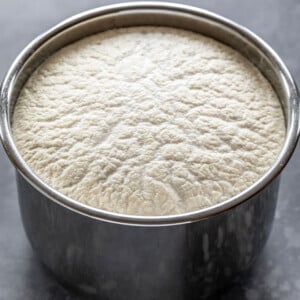
Ingredients
- 1 cup urad dal 200 grams, I use urad dal gota (whole deshusked black gram)
- 1 teaspoon fenugreek seeds
- 4 cups idli rice 800 grams
- 2 teaspoons sendha namak rock salt
Instructions
- Rinse the urad dal under running water. Then soak the dal in enough water (2-3 cups) for around 5 to 6 hours. Add 1 teaspoon methi seeds to the dal while it's soaking.
- Rinse the rice under running water until water turns clear. Then soak the rice in enough water for around 5 to 6 hours, same time as the dal.
- After 5 to 6 hours have passed, drain the water from the dal. Transfer the dal to the blender (or any grinder that you use).
- Add 1.25 (10 oz) to 1.5 cups (12 oz) ice cold water and grind the dal to a fine paste. I use my blendtec and press the smoothie or soup button usually.Transfer the ground dal to the steel pot of your Instant Pot (if using IP to ferment the batter) or to any other large container.
- Now drain the rice and add it to the same blender along with 1.5 (12 oz) to 2 cups (16 oz) ice cold water. Grind rice to a smooth paste. The amount of water will depend on the type of rice/dal you use. So, start with lesser amount and add more water as needed.
- Now, transfer the ground rice to the same pot as the dal. Add sendha namak (rock salt) to the rice and dal mixture.
- Now, start using your hands and mix the salt and the batter together for 1-2 minutes using your hands. Mixing by hands help in fermentation process.
- The consistency of the batter should be free flowing, but it shouldn't be runny.
- Now cover the pot with a glass lid (if using Instant Pot) or with any other lid if using regular container. The reason I use glass lid for fermenting the batter in Instant Pot and not it's regular lid is because the batter may overflow and that can lock the lid. So it's better to use a glass lid.
- If using Instant Pot for fermentation, now press the Yogurt button. Increase the time to 12-14 hours. The time will depend on where you live. Here it takes around 12-14 hours for the batter to ferment.If not using an Instant Pot, cover the container and place in an oven with lights on (especially if you live in a cold place). If you live in a very warm place, then simply keep the batter on the counter to ferment.
- After 14 hours, my batter was well fermented. It had increased in volume and was frothy and bubbly. To check you can also drop a small drop of batter in a bowl with clean water. The batter should float which means it's fermented. If not then it needs more time for fermentation.You can now use this idli dosa batter to make soft idli and crisp dosa!
- To make idli: grease idli plates and then fill them with the batter. Steam in a steamer for 10 to 12 minutes on high heat or in an Instant Pot for 13 mins with pressure valve in venting position (with 1 cup water in the pot to generate steam).Please note that when IP is in venting position, it doesn't display the time, so use an external timer.Cool for a minute or two and take idlis out of plates. Serve with sambar and coconut chutney.Also make crisp dosa with the same batter!
Notes
- Please do read all my tips and FAQs in the post before you attempt to make this recipe. Especially if you are new to making idli dosa batter, do not skip reading the post.
- Some people also add poha to the batter. You may if you want, add around 3 tablespoons poha and grind it along with the rice.
Nutrition
Nutrition information is automatically calculated, so should only be used as an approximation.
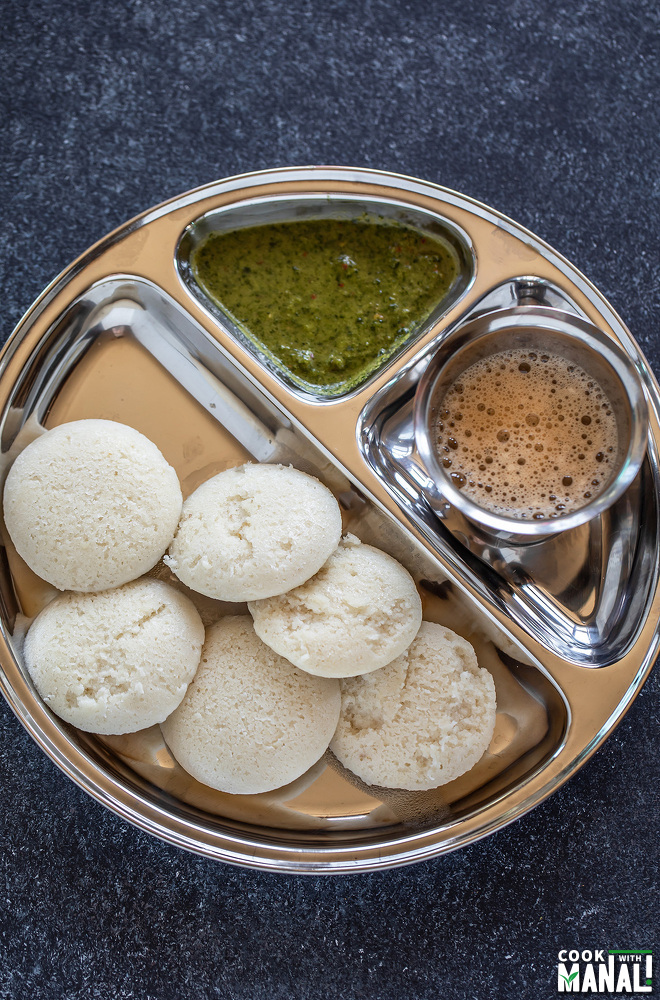
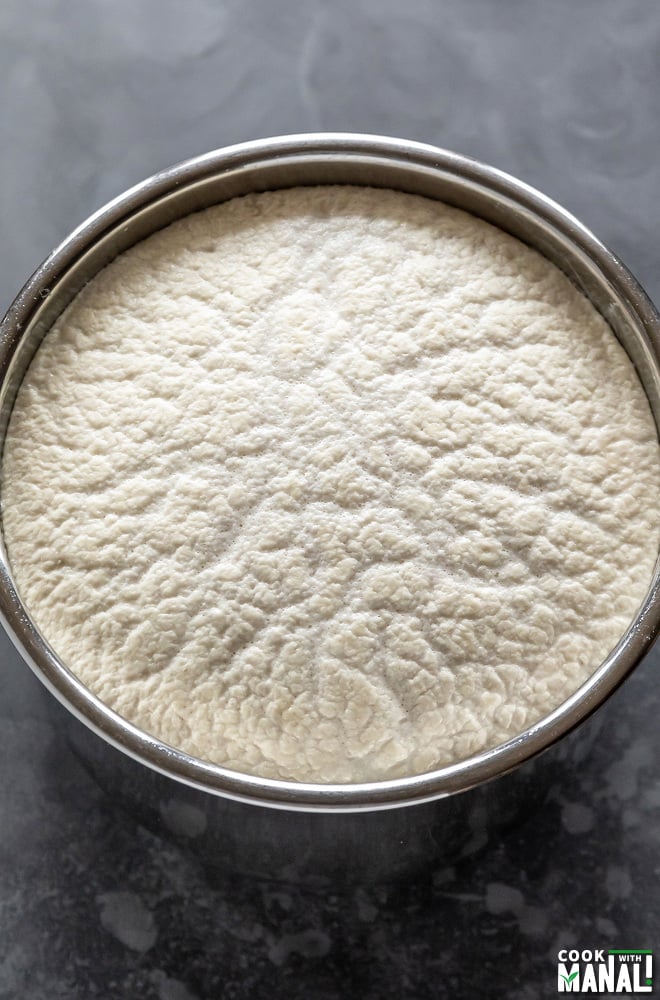
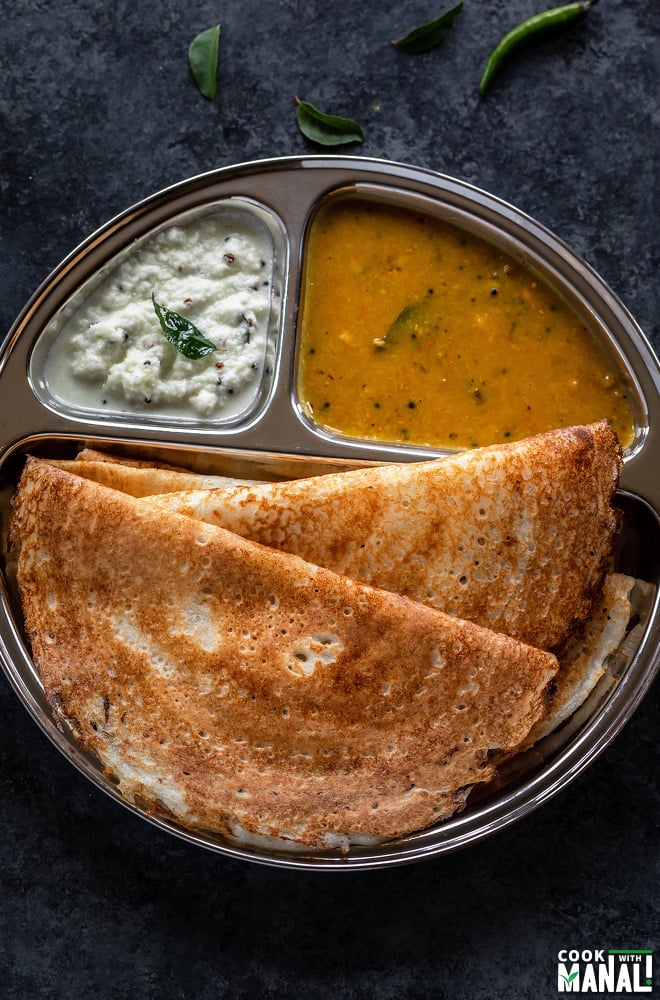
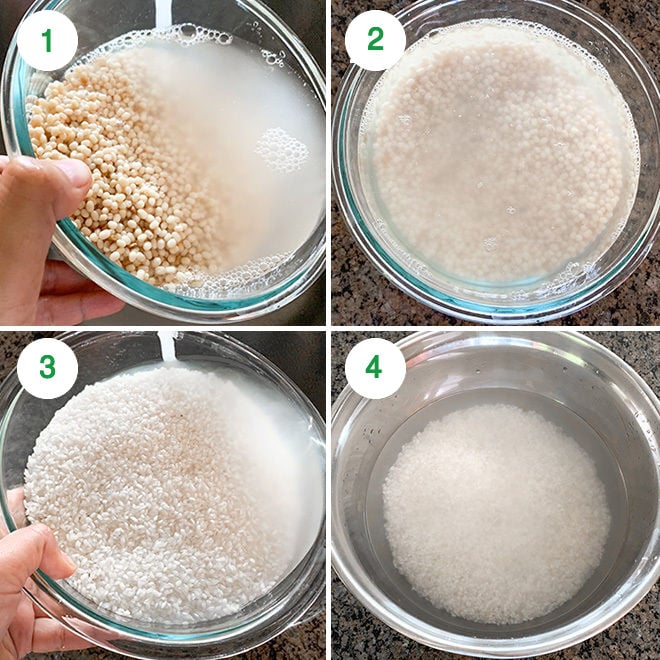
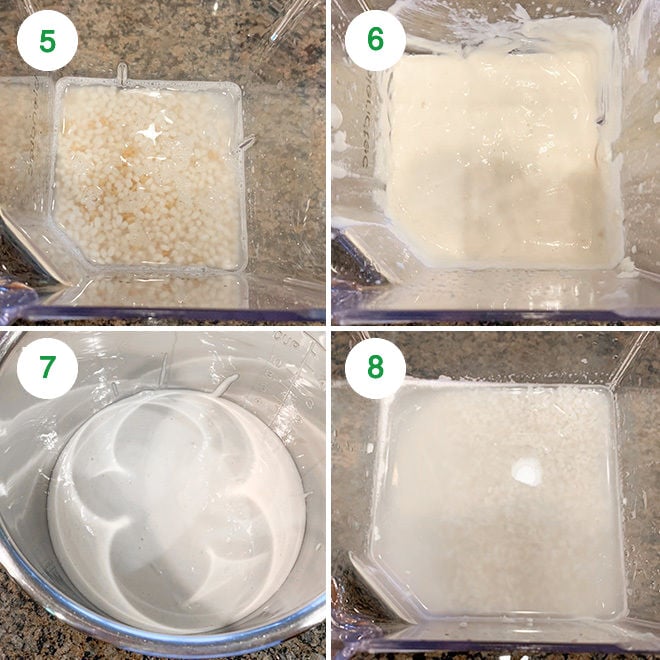
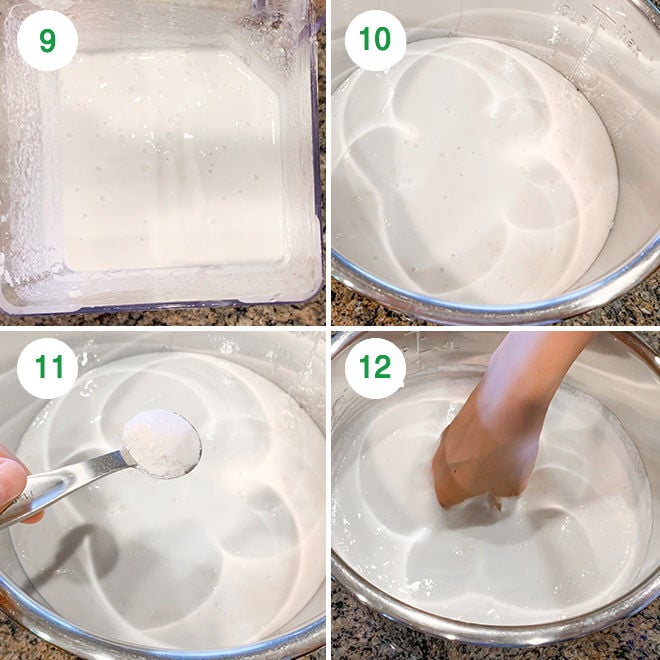
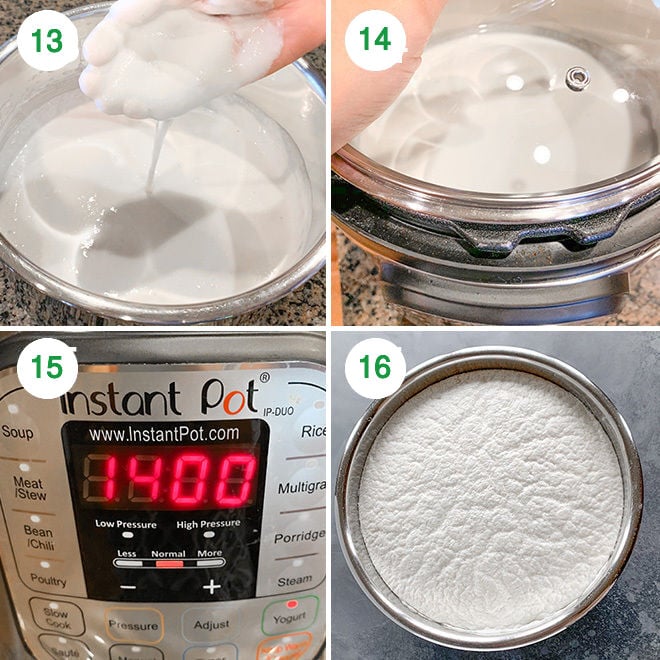
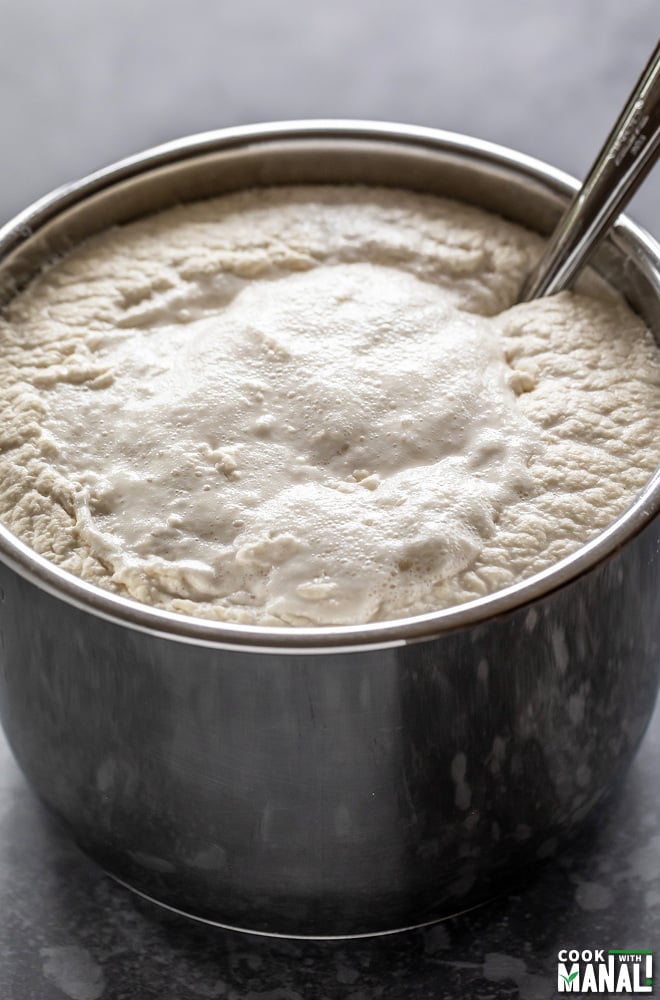

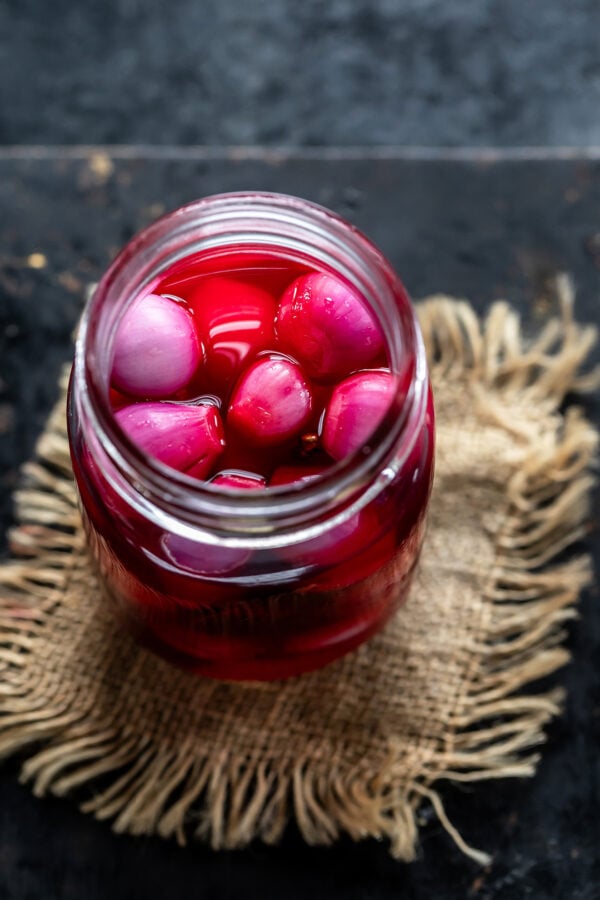
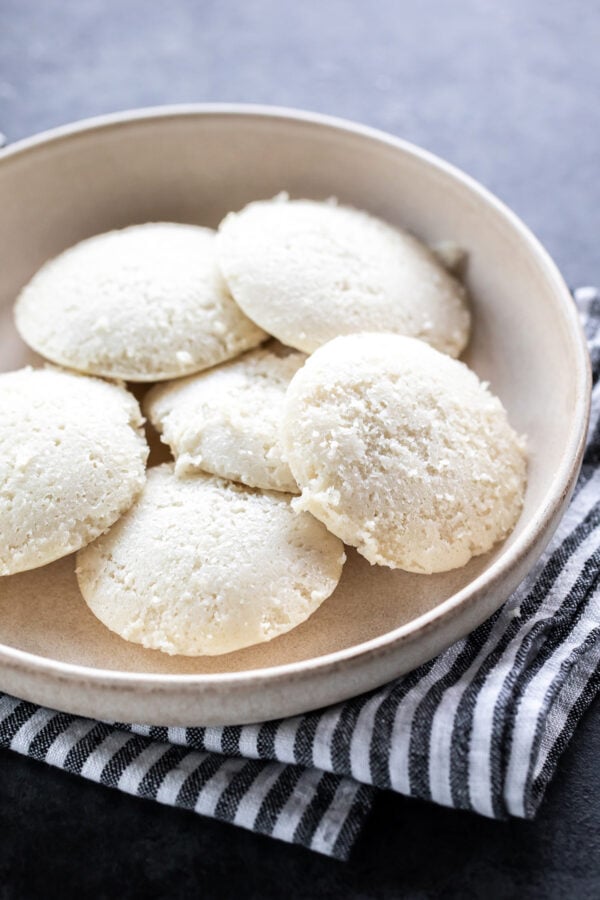
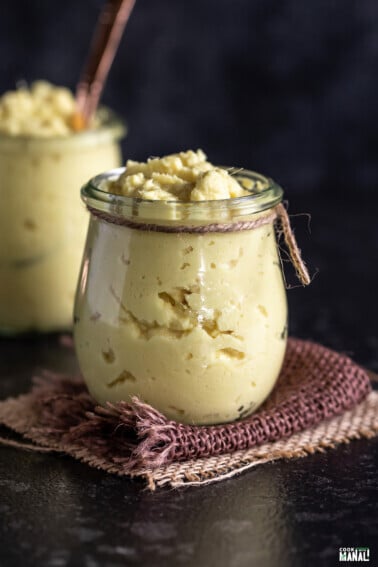
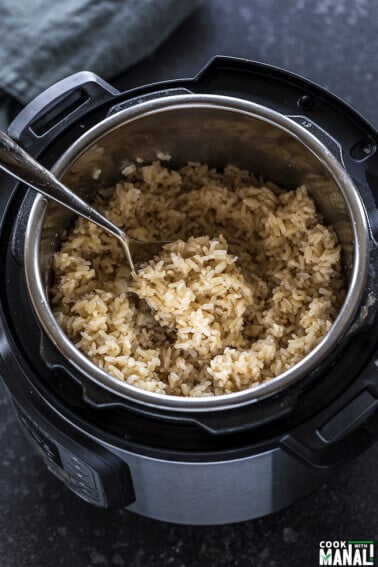









Hi Manali
How does the fermentation process work in Summer. Do we need less time? Until now, I was using the oven with light on to get the batter fermented. It is my first time in summer months in the country and wondering what would be the best way to get proper results. As spring is approaching the weather seems to be get pleasant and will be warmer now.
Thank you!
yes probably be done in 8 hours during summer. Oven with lights on works just fine as well.
Nice post! I can relate to each n everything you mentioned here about being north indian and less to no experience in cooking. I faced all these challenges too and can understand very well how life takes exams first and then teach us the lessons. 🙂
Recipe is wonderful, covered all the learnings very well. 🙂
Good luck to you and best wishes!
Thanks,
Rekha
Glad it resonated with you Rekha 🙂
Hi Manali
I heard that baking soda / powder helps in fermentation. At what stage should it be added? Also I would like to know what is the difference between the two and which should be added.
Hi Fatema, when we ferment idli and dosa batter naturally, we do not need any baking powder or baking soda. It ferments from the naturally occurring microorganisms which under optimal conditions break down the starch and release carbo dioxide just lifting the batter. I use ENO (fruit salt) or baking soda in instant batters where we don’t do this whole fermentation thing like rava idli: https://www.cookwithmanali.com/rava-idli/. You don’t need any baking soda in this recipe. The fermentation is supposed to occur naturally.
Hi Manali
After a few failed attempts, finally I managed to get full fermentation. Thank you very much.Guess, being in a colder country means more hours for fermentation. It took almost 16 hours but the end result is awesome.
I have few questions, please pardon my ignorance:
1. Once the batter is fermented, is it okay to refrigerate without any mixing. I should not disturb the batter or it does not really matter2. Once refrigerated, can I still use the batter to make idlis? All I have heard is that you should make idlis only out of the fresh batter and then store it for dosa / uttapas.3. Having a lot of bubbles in the batter, is a sign of something gone wrong ?4. Should Idli batter be thicker than dosa ?
Thank you for your time and guidance. It is much appreciated.
glad it worked Fatema. Yes you can refrigerate the batter once fermented. Whether you mix it or not, doesn’t matter after it has fermented. Yes, you can still use the batter to make idlis even after it has refrigerated. Bring it to room temperature though before making idlis. Having lot of bubbles just indicates fermentation, nothing wrong. Yes batter for idli should be thicker than dosa. I usually add some water to the batter while making dosa (take it out in another bowl). Hope that helps.
You have come to me in the form of blessing and are a huge help and guidance. Thank you once again!
you are most welcome. I am glad I could help! 🙂
Hi
My batter has turned very frothy and bit watery too. What went wrong?
batter does thin out a little after it has fermented, that’s why the batter before fermentation should be thick and flowing but not runny. Maybe you added more water while grinding the batter. The amount I have given is an estimate but it can vary depending on the quality of rice and dal being used. Hopefully the idlis turned out fine.
Sorry, I could not revive the batter. It turned very watery. I tried next batch and this time I did see some random rise in the pot here and there. So does it mean that fermnetation happened and I should leave it for more time. At some spots I saw froth, bubbles and batter had risen and other places it was just flat. I kept for 12 hours under Oven with light on. Does it need more time ? Should I just leave it for few more hours ?
yes leave for more time. You should do the water test and check. Drop some batter into a bowl of water, if it floats it means it is fermented. If it sinks, it means it’s still not fermented. I would give it more time. Batter should rise uniformly once fermented and not here and there. Unfortunately there are so many factors that effect the time it takes for the batter to ferment. If you live in a cold place, it can easily take more than 12 hours to ferment in winters. Also even it it doesn’t ferment, please make dosa out of it. They will come out okay.
Hi Manali. My instant pot does not have yogurt mode. Can i still make this?
yes of course, if you live in a cold place, just place the batter inside the oven with oven lights on (and oven off of course). You don’t need an instant pot to ferment your batter, it’s just one of the ways
Thanks for the recipe. If batter is less quantity how can I use pot in pot method?
you can use pot in pot method. just use a steel container and put it over trivet
Thanks for the recipe. Any specific brands for idli rice and urad gota in the US to get soft fluffy idlis? Its a hit or miss for me all the time.
I don’t have a favorite brand but I do think using fresh rice and dal makes a difference.
Thanks for such a great recepie
Hi Manali
Thanks a lot for all the details. One quick question please – with yogurt setting in Insta Pot, should I use the pressure cooker lid or just a plain glass lid ? With the pressure cooker lid, my batter didn’t rise.
Thanks
Shrabani
you can use any lid, there’s no pressure cooking happening on the yogurt mode so it doesn’t matter what lid you use. I usually use a glass lid because I have heard stories from people that sometimes that batter rises so much that the lid gets locked and then it’s difficult to remove it. Your batter not fermenting is likely due to other cause and not because of the lid.
Hi, thanks for the recipe! Have you had good luck halving the recipe – specifically with the smoothness of the grind in Blendtec?
I have not tried cutting the recipe in half but it should work
Hi Manali,
I have the pioneer woman instant pot and don’t have the yogurt setting. What is the yogurt setting for?
Thanks,
Jo
basically to make yogurt but we can use it in other things where temperature control is required like here in fermenting this batter
Hi.. I live in UK
When I added my batter in instaant pot in yogurt mode for 8 hours, all the better in the bottom was cooked and sticked to the steel pot. And the batter was spoiled. I don’t know where I’m wrong
Hi Latha, that’s strange, mine has never cooked on yogurt mode. Maybe try yogurt on “low” in place of regular next time. Maybe it’s a newer/different model that caused this?
The best way to do in cold climate is just cover the vessel with a blanket and roll it.
That’s works the best.I have done it and it works out perfect.
Thx very helpful will b making in th long wkend.
I wish to have Idli Dosa Batter.
Hi I do not have short or medium grain rice I have long grain rice from Walmart. Will it still work? Also, couldn’t find anywhere in your blog how much Dal and rice you took for your recipe and how many idlis it will make. Thank you.
Hi Maitry, all the details are in recipe card. Please scroll to the bottom or click “jump to recipe” button on top. You will find all the quantity there. yes try with long grain rice, should be okay
Hi Manali – thanks for the blog! How many times do you run the smoothie mode? And how much do you grind at 1 time. This seems to matter since blendtec heats up quickly.
It does heat up but I have never had a problem- I press the smoothie button and let it run the cycle, I think it’s 60 seconds? If you feel it still needs more grinding you can run more cycle. Mine is done in 1.
Hi Manali
Which idli stand you use? What size IP you have used?
Thank you for detailed explanation for the batter, it’s a master class 😊🙏
This is a 6qt Instant Pot. My idli stand is from India but really any idli stand will work, you can find so many on amazon!
Hi
Thanks so much for this blog.
I live in the UK and wish to buy an instant pot for fermenting purpose. Could you advise if yours is 3 quart or the 6 quart?
Also while fermenting in the yoghurt option, which temp setting to choose?
Thanks again
I have a 6qt. Yogurt – normal mode. Not high which is “boil” in yogurt mode and not the “less” either. Just normal. Once you buy the IP, read through the manual please.
Hi Manali,
The recipe looks helpful. I was looking to buy a wet grinder and have been reading online reviews on some of them since I usually have to go to the market to buy Dosa and Idli batter whenever I feel like eating Dosa/Idli. I know you haven’t used a wet grinder to make this batter, but would it be possible for you to suggest a wet grinder I can use weekly to make Dosa batter?
Thank You
Maybe try Preethi? I have heard good things about it, no personal experience though
How many dosas and idli does this recipe make? I will be making both dosas and idli from this batch for 7 people. Will this make enough idli and dosa for that many people or will I need to double the quantity?
it’s mentioned- it makes around 30 idlis
Which model of Blendtec do you use? My grinder has quit and I am thinking of buying a blender instead, and I am trying to decide between the Vitamix and the Blendtec. Thanks in advance.
I think I have the designer 650!
hello,
I have never made idli or dosa, but I have an idli steamer, and I’ve decided to have a go! BUT, where does the yeast come from? Some say the fenugreek seeds, but have you any other ideas?
Hello Bryan, it’s the yeast that’s present in the environment. Just like we make sourdough, same concept. Batter gets fermented from the yeast that’s present everywhere 🙂 fenugreek seeds aid in fermentation but they are not the one the causes fermentation.
For the ratio 4/ 1 which size of ip should be used 6qt or 8 qt as I am scared if it ferments and comes out of the sides.
Thank you
I have a 6qt and it works just fine. Please use a glass lid and not the regular lid of Instant Pot so that even if it over-ferments the Instant Pot doesn’t get locked.
Can I freeze a batch?
I have never frozen it but you can try!
Hi Manali, thanks for the detailed recipe. At what point do you grind and add fenugreek seeds to the ground batter?
along with the dal only since we soaked it with dal
Dear Manali, thank you so much for this recipe. I’ve travelled in Southern India and never forgot the taste of a idli/dosa/sambar breakfast. I’d never thought that I could make this myself but yes, it is possible and with your easy to follow recipe I brought memories and the taste of authentic Southern India cuisine back right into my kitchen in Europe. It is fantastic that now I can make this whenever I feel like. It increases my life quality! Thank you so much, I will definitely also try the samosa recipe and many many more!
so glad to hear that Ursula 🙂
Good and logical explanation
Fantastic recipe and it’s worked every time we try it. Any storage tips for the batter? Fridge is ok? We usually don’t have any left to store, but if I needed to make a bigger batch, I may have left overs
fridge is absolutely fine, good for 3-4 days easily in fridge
Hi- what should i do if my batter is a bit runny- are there any quick fixes?
I ended up adding a little
Extra water while grinding
try adding idli rava
If you added too much water, you can try adding Pohang or cooked rice. I think that should work
Dear Manali,
For the first time am so proud of myself for making perfect crispy dosas :))
I can’t thank you enough for all the work you have put into the trials and errors in arriving at the perfect process for perfectly fermented dosa batter !!!!!!
I live in New York. You might already know the winters here – even after 18 hours the batter would not ferment and in summers though temperatures are high here we live in a fully air conditioned home…so again batter would not ferment.
With the help of your post and my IP I got a perfectly fermented batter and am sooooo happy.
Thank you soooooo much :):):)
Yay! That makes me so happy Lakshmi!:) Thanks so much for trying the recipe and taking out time to leave a review. I understand how exciting it is when the batter finally ferments..haha.. I have been there so I know the feeling. Cheers to more dosas in the future! 🙂
Update : –
Today I made idlis with the same batter and they turned out soft and fluffy !!!!
Once again Thank you Manali :)))))))
Manali I have been your fan for many many years . I love all your recipes . I make them consistently especially your Tomato chutney u eat with idles . I have given your name and web to my daughter she also loves your instapot cooking and has tried many Indian recipes thank you so much . You r a great teacher . God Bless
Thanks Anita for your kinds words, it truly means a lot 🙂
What if you don’t have methi or rock salt? Can I use the regular rice?
You should use parboiled rice. Don’t use salt then at the beginning, use regular salt later when batter is fermented. Methi can be skipped but again recommended as it helps n fermentation.
Hi Manali. How much water should I and to the Idli batter for making Dosas. Please advise.
Thank you
Aruna
I usually eyeball it, start with 1 tablespoon and add more as needed. It should be thick but one that you can spread easily.
Hi Manali, I followed your recipe completely and batter ferment perfectly in IP when it is cold(50-60F).I live in bay area california. In summers qhen temp is( 80-100F) ,my batter never ferments. I tried putting on counter, in oven with lights on and without lights on and in Ip too. Also the inside house is always( 69-70f). I did not changed anything. Also is it split husked or whole husked daal..please help i have wasted 5lb rice and daal in trying the fermentatiom process. I use vitamix for blendinh.
hmm I am not sure why it wouldn’t ferment in summer. mine ferments much quicker in summers and I follow the same recipe. don’t change it. IP yogurt mode maintains the same temperature so irrespective of how it’s outside, the yogurt mode will have the same temperature. Try not adding the salt before since it’s summer. And add salt only once the batter is fermented and see if it works. I use urad dal gota (whole) but split also works!
Tried and it works perfectly! I always thought this was a complex
Process but now it seems easy:)
Thanks Manali! I tried your method and it worked !! I also live in Seattle and from north india so for obvious reason my batter wasn’t fermenting well and disappointing me every time . Thank you so much !!
yay awesome!
Hi, nice post!! I had tried your recipe and its good. I have one query-‘’my dosa sticks to nonstick pan where as idli turns-out good from same batter ?’’ what would be the reason? My cheela never sticks to the same pan .looking forward for replay .
Hi Sangeeta, sticking can be due to very hot temperature of the pan. I don’t see any other reason why it would stick on a non-stick pan. Run pan with a onion dipped in oil before making each dosa. Sprinkle and wipe pan with cold water each time after making a dosa. You need to regulate the heat of the pan, if it’s too hot, the dosa will stick. Also make sure the batter isn’t super thick. Add little water so that it’s easier to spread.
Nicely explained.. kudos 👏 to add on, Using dal soaked water for grinding helps fermentation better.
If I can’t find idli rice, which of the following options is better:
Raw ponni rice
Parboiled ponni rice
Raw sona masoori rice
Thanks in advance!
parboiled ponni rice